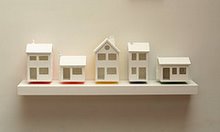What Exactly Does "Green Building" Mean?
LEED certification is a great marketing tool, but what does it mean?
“Green building” is the growing buzzword in construction and real estate these days. The concept of green building has gained favor with the general public, who perceive value in a building’s longevity and reduced maintenance costs.
As more and more homes and commercial buildings tout their “green building” status, few consumers actually understand what this means. In its most general sense, green building refers to a method of building that protects the heath of its occupants, efficiently uses water and energy and reduces the building’s impact to the environment.
Green building standards have been established by the U.S. Green Building Council’s Leadership in Energy and Environmental Design. The LEED rating system has emerged as a powerful tool to rate the design, construction and maintenance of a green building.
LEED ratings give points, or credits, for the presence or absence of several factors. At the lowest end of the ratings scale, a green building can be LEED Certified. The more credits a building is awarded, the greater chance of it being awarded the prestigious LEED Silver, Gold, or Platinum status.
LEED credits are awarded according to six factors:
SUSTAINABLE SITES
Where a developer chooses to build is a crucial first step. A green building will address density (for example, a mixed-use residential/commercial project) and access to the surrounding community. Alternative transportation is also considered. Does the building give its occupants easy access to public transportation? Incorporate bicycle storage? Address parking capacity and ride-sharing?
Other factors in sustainable sites include redeveloping a brownfield, restoring or protecting a habitat, and maximizing open spaces. A truly green building will also reduce the thermal difference between the building and surrounding environment. This is done with solar panels or light-reflecting roofs, as well as by planting trees and other vegetation around the site.
WATER EFFICIENCY
Landscaping is an important consideration in this step. In recent years, there has been a push to incorporate indigenous plants into the landscape of a potentially green building. This also means utilizing drought-tolerant or drought-resistant vegetation, as well as alternative watering methods.
Rainwater collection, drip irrigation, and graywater reuse are becoming popular in green buildings. Higher water efficiency is also established through the use of low-flow fixtures, such as energy and water-efficient toilets, shower heads, washing machines and dishwashers.
ENERGY AND ATMOSPHERE
A green building must have energy systems that are properly installed and calibrated. When operating, these systems must meet minimum standards of energy efficiency. A green building will further reduce ozone depletion by not using chlorofluorocarbon (CFC) refrigerants, not only in its heating and cooling, but in its fire suppression
Additionally, a green building will ideally reduce the demand for energy, perhaps by harvesting free energy or recovering wasted energy. Some green buildings also incorporate advanced monitoring systems that will easily point to problems within each system. Of course, green power is ideal, including the use of renewable energy sources such as solar, hydro and wind power.
MATERIALS AND RESOURCES
In order to be a green building, a close examination of the building’s construction is necessary. The program gives credits to building remodels where a significant portion of existing walls, floors and roof are reused. In the green building’s construction phase, waste management is taken into account.
Building materials that are recycled, created locally, or farmed from rapidly renewable materials are also highly desirable in a green building. These items may be found in flooring, insulation, architectural salvage, and myriad other methods. It should be noted that a green building must also have an on-site area for collecting recyclable materials.
INDOOR ENVIRONMENTAL QUALITY
Under this category, a green building must provide a healthful environment for its occupants. This is not only achieved through proper ventilation. In order to achieve this, builders must control or eliminate building materials that may emit hazardous contaminants, such as paints, sealants, finishes, stains and carpets.
A green building’s environmental quality is also measured by individuals’ ability to control temperature and lighting. By increasing the number of individual light switches and thermostats, occupants in a green building are more comfortable use less energy. And by designing primary living and working spaces around the perimeter, lighting costs are reduced, as well as increasing quality of life within the building.
INNOVATION IN DESIGN
Many consumers think that this category refers to the unique appearance of a green building. But innovation in design actually means that a building exceeds standards designated under the green building program. This can be achieved through design, technology, education and equipment.
Building owners can achieve innovation in design by utilizing Energy Star appliances, following green housekeeping procedures, saving water, and using natural pesticides in landscaping. Some green buildings earn these extra credits by tremendously exceeding the requirements other categories.








